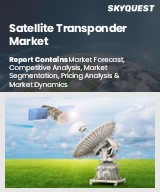
|
시장보고서
상품코드
1468187
위성 트랜스폰더 시장 보고서 : 대역폭, 서비스, 용도, 지역별(2024-2032년)Satellite Transponder Market Report by Bandwidth, Service, Application, and Region 2024-2032 |
||||||
세계 위성 트랜스폰더 시장 규모는 2023년 229억 달러에 달했습니다. IMARC 그룹은 2032년까지 시장 규모가 341억 달러에 달하고 2024-2032년간 연평균 성장률(CAGR)은 4.4%를 나타낼 것으로 예측했습니다.
위성 트랜스폰더는 위성에 연결하여 무선 신호를 송수신하는 무선 통신 장치입니다. 신호를 수신하면 다양한 주파수로 신호를 방송하여 GPS와 같은 다양한 식별, 위치 정보 및 내비게이션 시스템의 기능을 보조합니다. 또한 다운링크와 업링크 모두 서로 다른 주파수 값을 선택하여 신호 간 간섭을 방지합니다. 예를 들어, RFID(Radio-Frequency Identification Device, 무선 주파수 식별 장치)는 제어 지점의 요청에 따라 코드화된 신호를 전송합니다. 트랜스폰더의 출력 신호는 추적되고 그 위치는 지속적으로 모니터링됩니다. 또한, 입력(수신기)과 출력(송신기)의 주파수가 미리 할당되어 있어 수천 마일의 거리에서 장치를 작동시킬 수 있습니다.
시장 동향 :
고화질 TV(HDTV) 세트에 대한 수요 증가와 Ku 대역 용도의 확대가 시장 성장의 주요 요인입니다. 새로운 TV 플랫폼에 대한 수요 증가와 비디오 방송 가입자 수 증가로 인해 서비스 제공 업체는 위성 트랜스폰더를 사용하여 엔드 투 엔드 HD 비디오 전송을 제공하게 되었습니다. 또한 데이터, 비디오 및 음성 통신을 위한 Ku 대역 주파수의 채택률이 증가하고 있는 것도 시장 성장에 긍정적인 영향을 미치고 있으며, Ku 대역은 가입자에게 광대역 방송 및 통신을 위해 위성 트랜스폰더를 사용하며, Ku 대역 트랜스폰더는 다양한 초소형 개구부 터미널(VSAT), 모바일 백홀(MBH), 모바일 백홀(MBH), 모바일 백홀(MBH), 모바일 백홀(MBH), 모바일 백홀(MBH), 모바일 백홀(MBH), 모바일 백홀(MBH), 모바일 백홀(MBH), 항공 용도에도 널리 사용되고 있습니다. 또한 해상 광대역, 기내 통신, M2M(Machine-to-Machine) 통신에도 널리 도입되어 시장 성장을 더욱 촉진하고 있습니다. 예를 들어, 선박에 사용되는 자동 식별 시스템(AIS)은 트랜스폰더를 사용하여 통신하고 해상 레이더를 보완합니다.
본 보고서에서 다룬 주요 질문
- 2023년 위성 트랜스폰더 세계 시장 규모는?
- 2024-2032년 위성 트랜스폰더 세계 시장 성장률 전망은?
- 코로나19가 위성 트랜스폰더 세계 시장에 미치는 영향은?
- 위성 트랜스폰더 세계 시장을 이끄는 주요 요인은?
- 대역폭을 기준으로 한 위성 트랜스폰더 세계 시장 현황은?
- 위성 트랜스폰더 세계 시장의 서비스별 분류는?
- 위성 트랜스폰더 세계 시장 용도별 분류는?
- 위성 트랜스폰더 세계 시장의 주요 지역은?
- 위성 트랜스폰더 세계 시장의 주요 기업은?
목차
제1장 서문
제2장 조사 범위와 조사 방법
- 조사 목적
- 이해관계자
- 데이터 소스
- 1차 정보
- 2차 정보
- 시장 추정
- 보텀업 접근
- 톱다운 접근
- 조사 방법
제3장 주요 요약
제4장 서론
- 개요
- 주요 산업 동향
제5장 세계의 위성 트랜스폰더 시장
- 시장 개요
- 시장 실적
- COVID-19의 영향
- 시장 분석 : 대역폭별
- 시장 분석 : 서비스별
- 시장 분석 : 용도별
- 시장 분석 : 지역별
- 시장 예측
제6장 SWOT 분석
- 개요
- 강점
- 약점
- 기회
- 위협
제7장 밸류체인 분석
제8장 Porter의 Five Forces 분석
- 개요
- 바이어의 교섭력
- 공급 기업의 교섭력
- 경쟁 정도
- 신규 진출업체의 위협
- 대체품의 위협
제9장 시장 분석 : 대역별
- C-band
- 시장 동향
- 시장 예측
- KUv
- 시장 동향
- 시장 예측
- KA-band
- 시장 동향
- 시장 예측
- K-band
- 시장 동향
- 시장 예측
- 기타
- 시장 동향
- 시장 예측
제10장 시장 분석 : 서비스별
- 리스
- 시장 동향
- 시장 예측
- 유지보수 및 지원
- 시장 동향
- 시장 예측
- 기타
- 시장 동향
- 시장 예측
제11장 시장 분석 : 용도별
- 상업 통신
- 시장 동향
- 시장 예측
- 정부 통신
- 시장 동향
- 시장 예측
- 내비게이션
- 시장 동향
- 시장 예측
- 원격 탐사
- 시장 동향
- 시장 예측
- 연구개발
- 시장 동향
- 시장 예측
- 기타
- 시장 동향
- 시장 예측
제12장 시장 분석 : 지역별
- 북미
- 시장 동향
- 시장 예측
- 유럽
- 시장 동향
- 시장 예측
- 아시아태평양
- 시장 동향
- 시장 예측
- 중동 및 아프리카
- 시장 동향
- 시장 예측
- 라틴아메리카
- 시장 동향
- 시장 예측
제13장 경쟁 구도
- 시장 구조
- 주요 기업
- 주요 기업 개요
- SES S.A.
- Arabsat
- Eutelsat S.A.
- Intelsat Corporation
- Embratel Star One
- Thaicom Public Company Limited
- Sky Satellite LLC
- SKY Perfect JSAT Corporation
- HISPASAT S.A.
- Singtel Group
- Telesat
The global satellite transponder market size reached US$ 22.9 Billion in 2023. Looking forward, IMARC Group expects the market to reach US$ 34.1 Billion by 2032, exhibiting a growth rate (CAGR) of 4.4% during 2024-2032.
A satellite transponder is a wireless communication device that is connected to a satellite for receiving and transmitting radio signals. Upon receiving the signal, it broadcasts it at varying frequencies that assists in the functioning of various identification, location and navigation systems such as GPS. Also, it selects different frequency values for both downlink and uplink to prevent the interference between signals. For instance, the Radio-Frequency Identification Device (RFID) transmits a coded signal upon receiving a request from a control point. The transponder output signal is tracked, and its position is continuously monitored. In addition, the input (receiver) and output (transmitter) frequencies are pre-assigned through which the device can operate over distances of thousands of miles.
Market Trends:
The increasing demand for High Definition Television (HDTV) sets and expansion in the Ku band applications are the key factors driving the growth of the market. The growing demand for new television platforms and rising number of video broadcasting subscribers have led the service providers to utilize satellite transponders to provide end-to-end HD video transmission. Furthermore, increasing adoption rates of Ku band frequencies for data, video and voice communications have positively impacted the market growth. The Ku band utilizes satellite transponders for high-bandwidth broadcasting and communication to the subscribers. Ku-band transponders are also used extensively for various Very-Small-Aperture Terminals (VSAT), mobile backhaul (MBH) and aeronautical applications. Additionally, the widespread implementation of the device in maritime broadband, in-flight and machine-to-machine (M2M) communications has further favored the market growth. For instance, the Automatic Identification System (AIS) used in ships utilizes transponders to communicate and supplement marine radar.
Key Market Segmentation:
IMARC Group provides an analysis of the key trends in each sub-segment of the global satellite transponder market report, along with forecasts at the global and regional level from 2024-2032. Our report has categorized the market based on bandwidth, service and application.
Breakup by Bandwidth:
C-Band
KU-Band
KA-Band
K-Band
Others
Breakup by Service:
Leasing
Maintenance and Support
Others
Breakup by Application:
Commercial Communications
Government Communications
Navigation
Remote Sensing
R&D
Others
Breakup by Region:
North America
Europe
Asia Pacific
Middle East and Africa
Latin America
Competitive Landscape:
The report has also analysed the competitive landscape of the market with some of the key players being SES S.A., Arabsat, Eutelsat S.A., Intelsat Corporation, Embratel Star One, Thaicom Public Company Limited, Sky Satellite LLC, SKY Perfect JSAT Corporation, HISPASAT S.A., Singtel Group, Telesat, etc.
Key Questions Answered in This Report
- 1. What was the size of the global satellite transponder market in 2023?
- 2. What is the expected growth rate of the global satellite transponder market during 2024-2032?
- 3. What has been the impact of COVID-19 on the global satellite transponder market?
- 4. What are the key factors driving the global satellite transponder market?
- 5. What is the breakup of the global satellite transponder market based on the bandwidth?
- 6. What is the breakup of the global satellite transponder market based on the service?
- 7. What is the breakup of the global satellite transponder market based on the application?
- 8. What are the key regions in the global satellite transponder market?
- 9. Who are the key players/companies in the global satellite transponder market?
Table of Contents
1 Preface
2 Scope and Methodology
- 2.1 Objectives of the Study
- 2.2 Stakeholders
- 2.3 Data Sources
- 2.3.1 Primary Sources
- 2.3.2 Secondary Sources
- 2.4 Market Estimation
- 2.4.1 Bottom-Up Approach
- 2.4.2 Top-Down Approach
- 2.5 Forecasting Methodology
3 Executive Summary
4 Introduction
- 4.1 Overview
- 4.2 Key Industry Trends
5 Global Satellite Transponder Market
- 5.1 Market Overview
- 5.2 Market Performance
- 5.3 Impact of COVID-19
- 5.4 Market Breakup by Bandwidth
- 5.5 Market Breakup by Service
- 5.6 Market Breakup by Application
- 5.7 Market Breakup by Region
- 5.8 Market Forecast
6 SWOT Analysis
- 6.1 Overview
- 6.2 Strengths
- 6.3 Weaknesses
- 6.4 Opportunities
- 6.5 Threats
7 Value Chain Analysis
8 Porter's Five Forces Analysis
- 8.1 Overview
- 8.2 Bargaining Power of Buyers
- 8.3 Bargaining Power of Suppliers
- 8.4 Degree of Competition
- 8.5 Threat of New Entrants
- 8.6 Threat of Substitutes
9 Market Breakup by Bandwidth
- 9.1 C-Band
- 9.1.1 Market Trends
- 9.1.2 Market Forecast
- 9.2 KU-Band
- 9.2.1 Market Trends
- 9.2.2 Market Forecast
- 9.3 KA-Band
- 9.3.1 Market Trends
- 9.3.2 Market Forecast
- 9.4 K-Band
- 9.4.1 Market Trends
- 9.4.2 Market Forecast
- 9.5 Others
- 9.5.1 Market Trends
- 9.5.2 Market Forecast
10 Market Breakup by Service
- 10.1 Leasing
- 10.1.1 Market Trends
- 10.1.2 Market Forecast
- 10.2 Maintenance and Support
- 10.2.1 Market Trends
- 10.2.2 Market Forecast
- 10.3 Others
- 10.3.1 Market Trends
- 10.3.2 Market Forecast
11 Market Breakup by Application
- 11.1 Commercial Communications
- 11.1.1 Market Trends
- 11.1.2 Market Forecast
- 11.2 Government Communications
- 11.2.1 Market Trends
- 11.2.2 Market Forecast
- 11.3 Navigation
- 11.3.1 Market Trends
- 11.3.2 Market Forecast
- 11.4 Remote Sensing
- 11.4.1 Market Trends
- 11.4.2 Market Forecast
- 11.5 R&D
- 11.5.1 Market Trends
- 11.5.2 Market Forecast
- 11.6 Others
- 11.6.1 Market Trends
- 11.6.2 Market Forecast
12 Market Breakup by Region
- 12.1 North America
- 12.1.1 Market Trends
- 12.1.2 Market Forecast
- 12.2 Europe
- 12.2.1 Market Trends
- 12.2.2 Market Forecast
- 12.3 Asia Pacific
- 12.3.1 Market Trends
- 12.3.2 Market Forecast
- 12.4 Middle East and Africa
- 12.4.1 Market Trends
- 12.4.2 Market Forecast
- 12.5 Latin America
- 12.5.1 Market Trends
- 12.5.2 Market Forecast
13 Competitive Landscape
- 13.1 Market Structure
- 13.2 Key Players
- 13.3 Profiles of Key Players
- 13.3.1 SES S.A.
- 13.3.2 Arabsat
- 13.3.3 Eutelsat S.A.
- 13.3.4 Intelsat Corporation
- 13.3.5 Embratel Star One
- 13.3.6 Thaicom Public Company Limited
- 13.3.7 Sky Satellite LLC
- 13.3.8 SKY Perfect JSAT Corporation
- 13.3.9 HISPASAT S.A.
- 13.3.10 Singtel Group
- 13.3.11 Telesat

















